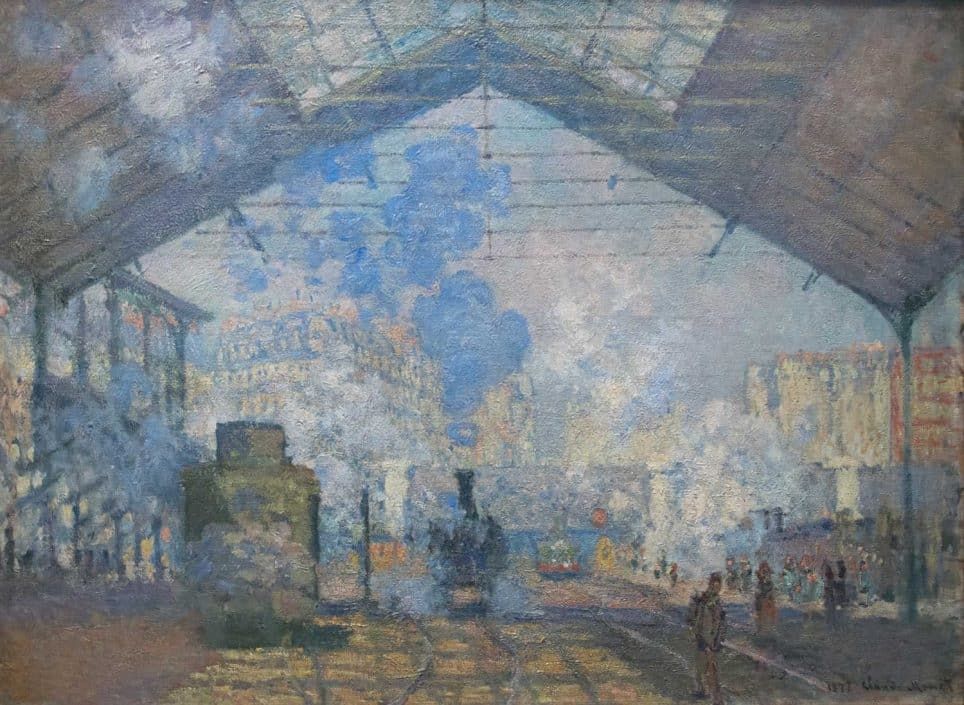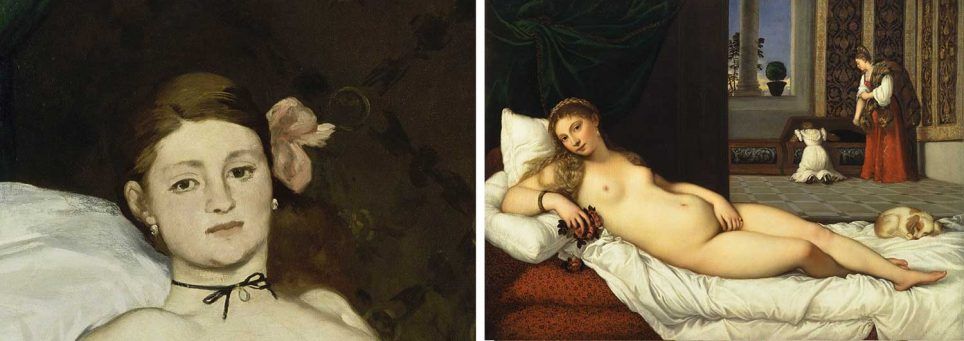Edouard Manet, The railroad1873
i
Oil on canvas • 93.3 × 111.5 cm • Coll. National Gallery of Art, Washington
Like a long silence, at the edge of the tracks. Here are two crinolines complementary who pose outside. One is older, dark blue, perfectly indifferent to the spectacle of the locomotive. Seated to the left of the frame, she faces us, wearing a black hat and flowers. Her red hair is down. On her thighs: a sleeping puppy, a fan, a book. Of Zola ? The Human Beast ?
Steam which crosses the table indicates the reading direction. The pages are thick, opening like the lace of the dress sleeves. She stops reading right now. We are not sure a ghostly reading lamp by Camille Corot [voir plus bas], this one stares at us with firm confidence and reddened cheeks. Who is she ? The mother, the big sister, the cousin, the most so young au pair?
An air of Degas
His little neighbor is clinging to the gates, like at the Fernando circus. Arms in the air, she daydreams, absorbed by the fumes of a train. THE ccho-choo merry-go-round and swirls of smoke fascinate as much as Miss Lala’s acrobatics on horseback. The spectator must have between five and ten candles. For her afternoon walk, she wore a silk taffeta dress. She stands with her back, standing, elegantly dressed. It is believed to the girls of the Bellelli clan painted by Edgar Degas. Her hair is tied back with a headband, the nape of her neck is clear, as clear as a candy. Innocent little one, behind bars. Escape in progress. No need for wings to fly like an angel, curls of a sky blue ribbon are enough to make it float above the clouds.
On the left and right, details of “Chemin de fer” by Édouard Manet, 1873. In the center, detail of “La lecture interrupte” by Camille Corot, circa 1870 and detail of “Family portrait” by Édgar Degas, between 1858 and 1869
i
Oils on canvas • © NGA. © Art Institute Chicago. © Bridgeman Images / Musée d’Orsay, Paris. © NGA
The train has already passed, only its steamers lag behind. The whistle of the machines must also dissipate. He won’t have woken up the little dog. Where are they exactly? In the street, in a garden? The iron gate is not so clear. A bunch of grapes is placed on the border parapet. On the right, a balcony extends its guardrail with iron crossings. Foliage covers this part of the painting. A signal box squeals below, the station must not be very far away. To the left or to the right ? On arrival or departure? Who knows. On the other side of the track and the fumaroles, at the back of the painting, we can see downtown elements : massive lintels, carved pediments, balusters on the windows. The decor is cozy, some city dwellers today will recognize their building. But what will they read in the look of this lady who is looking at us?
“A rather unique task”
Edouard Manet painted The railroad in 1873, partly in the garden of his friend Alphonse Hirsch which is at the intersection of the streets of Rome and Constantinople, facing the quays. He refines the canvas in his workshop, located at 4 rue de Saint-Pétersbourg, a stone’s throw from Saint-Lazare. The station is a “temple of progress”, according to Théophile Gautier, and a subject of modern-day painting.

Edouard Manet, The Railway (detail)1873
i
Oil on canvas • 93.3 × 111.5 cm • Coll. National Gallery of Art, Washington
In three years, Claude Monet will paint Saint-Lazare twelve times. Steam locomotives like orchards in bloom, with lighting effects from hour to hour. In the meantime, it is Manet who sticks to it and presents his painting to the Salon of 1874. That year, the not-yet-impressionists dissent at Nadar’s. Manet does not want to be associated with the refused. He who values official recognition will not be disappointed.
“Manet does a task singular enough for ignorant eyes, spoiled by all the kindnesses of our art, to see the thing purely as a comic thing. If we hung a Goya in the Salon, we would twist. »
Emile Zola
His train will be whistled, rather twice than once. THE Tintamarre from May 10, 1874 renames the canvas to Railway to Charenton. A mocking extension which mentions the city hosting an insane asylum. The painting is criticized for its compressed plans, its incoherent composition, its summary execution. Already, in 1863, Le Luncheon on the Grass And The Olympia shook the crowds. Manet nevertheless played again the icons of the great master Titian : THE Country concert (1500–1525) and the Venus of Urbino (1538). He is surprised to see the bourgeois republicans of his class so conservative. In the 19th centurye century, the only nudity authorized must cite mythology. The slightly fake-assed top hats are shocked by Victorine Meurentthis model-vehicle which advances, insolent, indifferent. The railroad will be moreover his last appearance, for a final outcry. Even dressed.


Claude Monet, Saint-Lazare Station1877
i
Oil on canvas • 75 × 105 cm • Coll. Orsay Museum, Paris
After his visit to the Salon of 1874, Émile Zola reacted to the criticisms made of the painting: “Manet does a task singular enough for ignorant eyes, spoiled by all the kindnesses of our art, see the thing purely as a comedy. If we hung a Goya in the Salon, we would twist. » Goya, this other Source of inspiration for Manet. The Execution of Maximilian (1868) responds in particular to the famous Lots of mayo (1814). A silent interpretation which is no longer frankly in the signifier. “Manet twists the neck of eloquence,” said André Malraux. “This painting recalls the numbing of an anesthetized tooth.” What to think of Railway ? What do they have to tell us the silent ways by Manet? Are they so impenetrable?
The discreet charm of the 19th centurye century
At the edge of Railway, we are in Saint-Lazare, really? It could be anywhere, whenever. In Waterlitz or Austerloo. Why this grape, placed there on the right on the low wall, for no reason? The coronation cannot be explained, it is felt. It can also be guessed, through some divine inspirations. The sleeping dog could well wink at the Venus of Urbino by TitianAgain.


On the left, detail of the “Olympia” by Édouard Manet, 1863. On the right, the “Venus of Urbino” by Titian, 1538
i
Oils on canvas • Coll. Orsay Museum, Paris. © Uffizi Gallery, Florence / Bridgeman Images
The two crinolines without cuteness could evoke other great classics. THE Portrait of a lady of quality and her daughter (1628) by Van Dyck For example ? Why not ? A lady sits proudly, detached in satin black next to her little one. At the edge of the railway, the silence is even colder. The little girl turned away, under hypnosis, lost in a backwards tale. On the other hand, Victorine stares at us. Indifferent to the industrial merry-go-round, she calls out to us, looks at us: “How can I help you? »
“One train can hide another,” the sign tells us, The railroad repeats it to us. In this shot, the escape is toast, the perspective gone up in smoke.
Not really invited, looks come forward despite everything. If the guardrail of Balcony (1868) [ill. ci-dessous] leaves us outside the frame – both spectator and spectacle –, bars of Railway encourage us to join the little spinning top. Like her, we go through the details at the side of the track, before going back up to the other side. Over there is the door to Manet’s studio.


On the left, “Tres de Mayo” by Francisco de Goya, 1814; On the right, “The Execution of Maximilien” by Édouard Manet, 1868-1869
i
Oils on canvas • Coll. Prado Museum. Coll. Kunsthalle Mannheim / © Bridgeman Images
This (documented) anecdote allows us to imagine the artist hiding behind the volutes like Velázquez scrutinizing his sky blue Menina. And we who are at his side, we are surprisedas spectators watched… In The discreet charm of the bourgeoisie (1972), Luis Bunuel will also trap his own, in another style. By moving his camera during one of the many dinners of a eccentric troupe, he makes appear its actors on a theater stage. The viewer of the film is duplicated, split. He sees himself, and is surprised, among the voyeuristic ranks.
“One train can hide another,” the sign tells us, The railroad repeats it to us. In this plan, the escape is toast, the perspective gone up in smoke. The station – this temple of progress – is out of frame. At Manet, the fumes of Saint-Lazare are not a pretext for capturing luminous impressions, it would rather be a matter of probe our inner illusions.


On the left, “Le Balcon” by Édouard Manet, between 1868–1869. On the right, detail from “Chemin de Fer” by Édouard Manet, 1873
i
Oils on canvas • Coll. Musée d’Orsay, Paris / Coll. National Gallery of Arts, Washington
Let’s reread Zola : “If we hung a Goya in the Salon, we would twist. » The Spanish painter rejected, completely disgusted, the Enlightenment of his time, this rationalist and empiricist movement which did not prevent civilized man from committing the worst massacres. In his silence, Manet could well depict a equivalent dead endwith the anesthetized visions of its bourgeois class twisted with embarrassed laughter. 2024–1874; 150 years of an interior journey, with a scent of terminus lingering, like a background note to better question our times. After Manet, who to signal a new beginning?












